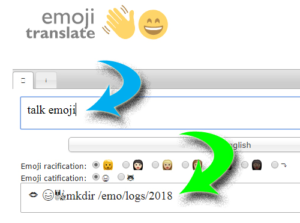SIGN LANGUAGE
–
 –
–
I don’t speak emoji. There; I’ve said it. I’m not embarrassed, nor am I feeling even the least bit inferior or substandard. In fact, as I write this post, I’m noticing that my word processing program, which was developed by Microsoft and has a huge following as perhaps the most widely used word processing program in the world, doesn’t speak emoji either. It just sees it as a misspelled word, with no suitable correction and zero suggestions for synonyms. The program, backed by years of development to enhance the fine art of communication, is suggesting that I change the word to email or emotion. Emotive is also on the list, but I’m just not feeling all that emotive in the moment.
 Being non-fluent in emoji, as I confess to be, I took the time to ask Google for some help and found myself looking at a webpage that translates from English to Emoji or vice versa. Google also alerted me to the fact that the webpage was insecure. So, feeling insecure myself, I only stayed long enough to snap a screenshot before closing the window and flushing my internet cache. That’s the backstory of how the photo image for this post came to be, but that’s not what this post is really about.
Being non-fluent in emoji, as I confess to be, I took the time to ask Google for some help and found myself looking at a webpage that translates from English to Emoji or vice versa. Google also alerted me to the fact that the webpage was insecure. So, feeling insecure myself, I only stayed long enough to snap a screenshot before closing the window and flushing my internet cache. That’s the backstory of how the photo image for this post came to be, but that’s not what this post is really about.
When I think emoji, I think of how we are making an effort to simplify communication in our modern world by returning to the days of hieroglyphics. I’m not saying that’s a bad thing in and of itself, but we must keep in mind that only those who spoke bird, watermark, and curlicue really knew what was intended by bird, watermark, and curlicue. For everyone else, it was a matter of reading between the cartoons, so to speak.
It strikes me as odd that this trend has broken out and caught fire in a day and age when so many are so offended by so little. It seems like we’re living in a time in which we need to choose our words with ultimate care and consideration. On the other hand, leaving an open loophole of plausible deniability may be the optimum way to go. Being able to correct a public outburst by saying, “No… that little fire, fence post, heart trilogy didn’t mean that I wanted to burn the witch at the stake and watch her heart melt. It meant that I understood how she felt so alone and I wanted wave a magic wand that would light a fire inside to comfort her and warm her little heart.”
When it comes to communication, I’m still locked in the world of rearranging the 26 letters that have been passed down through generations and I do my best to include proper punctuation. For me, “I’m hungry! Let’s eat grandma!” and “I’m hungry; Let’s eat, grandma.” are two entirely different directives.
I confess; I’m still grappling with my overuse of question marks. I drop them in as a threesome when I’m attempting to emote bewilderment. “Are you kidding me???” just seems better with three question marks, even though I know it’s erroneous and abusive. Hopefully, my readers will overlook this lingering flaw.
Exclamation points are the most alarming and easily misunderstood though. They can imply excitement, confidence, or anger. I’ve learned that you have to use them with care and I’ve learned to leave them to the whim of those more highly skilled than I, whenever possible.
A few weeks ago, I stood up for the F Word. This morning, I’d like to take a stand on Exclamation Points and ask that those of us who still use the reliable 26 to communicate reserve Exclamation Points for only extreme circumstances when their use is, not only warranted, but also inherently clear. As a side note, they should never, ever follow the words “Thank You!” unless you are indeed pushed to the edge and trying to politely tell someone that you’ve had enough, in no uncertain terms.
I received a “Thank You!” note this past week in a short business exchange and the usage was unclear. Was the person showing a measure of appreciation for my touching base with them, as requested by their employer? Or, were they annoyed that I had done my job, as the employer had requested and reached out to them with a short email to provide my contact info? I’d like to think positively about the response, but “I’m good! Thank You!” just reads differently than “I’m good; thanks.”
Honestly, there’s room to read the response as a courteous reply or as a statement of utter irritation. The Exclamation Point is a deceptive dagger and, when thrown about carelessly, it can easily be misinterpreted. Maybe emoji language is more useful. Had I gotten a smiley face, the only question would have been if it was a sincere smiley or one added to the end of the sentence to imply sarcasm. But, surely there’s a sarcastic smirk emoji for that. Had the Howard Beale / Network or William Foster / Falling Down emoji been attached, the sentiment would have been supremely explicit, right?
I think I’m beginning to see the light. Perhaps it’s time for me to embrace the world of emoji after all. In the meantime, let’s all strive to play it safe with punctuation and keep our left pinky fingers away from our exclamation point key until we’ve exhausted all other punctuation options. Earth emoji. Flexing bicep emoji. Waterfall emoji. Heart emoji. (The world will be stronger and filled with love.)
Now, could someone please explain what Mud Flap Girl sitting inside of a Poop emoji means??? I’m bewildered.
–
Quick Links to Mark’s Books on Amazon:
| PUSH Mark D. Combs |
Don’t Forget Your Cape Mark D. Combs |
HELLO… IS THIS ON? Mark D. Combs |
–


